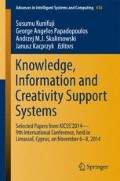Abstract
Today’s smartphones are capable of doing much more than the previous generation of mobile phones. However this extended range of capabilities is coming together with some new security risks. Also, mobile platforms often contain small, insecure and less well controlled applications from various single developers. Due to the open usage model of the Android market, malicious applications cannot be avoided completely. Especially pirated applications or multimedia content in popular demand, targeting user groups with typically low awareness levels are predestined to spread too many devices before being identified as malware. Generally malware applications utilizing root exploits to escalate their privileges can inject code and place binaries outside applications storage locations. This paper proposes a novel approach, which uses minimum computational power and resources, to indentify Android malware or malicious applications. It is a bio-inspired Hybrid Intelligent Method for Detecting Android Malware (HIMDAM). This approach performs classification by employing Extreme Learning Machines (ELM) in order to properly label malware applications. At the same time, Evolving Spiking Neural Networks (eSNNs) are used to increase the accuracy and generalization of the entire model.
Access this chapter
Tax calculation will be finalised at checkout
Purchases are for personal use only
References
Alam M.S., Vuong S.T.: Random forest classification for detecting android malware. In: IEEE IC on Green Computing and Communications and Internet of Things (2013)
Amos, B.: Antimalware. https://github.com/VT-Magnum-Research/antimalware (2013)
Barrera, D., Kayacik, H., Oorshot, P., Somayaji, A.: A Methodology for Empirical Analysis of Permission-Based Security Models and its Application to Android. ACM (2010)
Burguera, I., Zurutuza, U., Nadjm-Tehrani, S.: Crowdroid: behavior-based malware detection system for android. In: 1st ACM Workshop on on SPSM, pp. 15–26. ACM (2011)
Cambria E., Huang G.-B.: Extreme learning machines. IEEE Intell. Syst. (2013)
Cheng, C., Peng, W.T, Huang, G.-B.: Extreme learning machines for intrusion detection. In: WCCI IEEE World Congress on Computational Intelligence Brisbane, Australia (2012)
Chin E., Felt A., Greenwood K., Wagner D.: Analyzing inter-application communication in android. In: 9th Conference on Mobile Systems, Applications, and Services, pp. 239–252. ACM (2011)
Delorme, A., Perrinet, L., Thorpe, S.J.: Networks of Integrate-and-fire neurons using rank order coding b: spike timing dependant plasticity and emergence of orientation selectivity. Neurocomputing 38–40(1–4), 539–545 (2000)
Enck, W., Ongtang, M., McDaniel, P.: On lightweight mobile phone application certification. In: Proceedings of the 16th ACM Conference on Computer Security, CSS (2009)
Fedler, R., Banse, C., Krauß, Ch., Fusenig, V.: Android OS security: risks and limitations a practical evaluation, AISEC Technical Reports, AISEC-TR-2012–001 (2012)
Fuchs, A., Chaudhuri, A., Foster, J.: ScanDroid: automated security certification of android applications, Technical report, University of Maryland (2009)
Ghorbanzadeh, M., Chen, Y., Zhongmin, M., Clancy, C.T., McGwier, R.: A neural network approach to category validation of android applications. In: International Conference on Computing, Networking and Communications, Cognitive Computing and Networking Symposium (2013)
Glodek, W., Harang R.R.: Permissions-based detection and analysis of mobile malware using random decision forests. In: IEEE Military Communications Conference (2013)
Google, UI/Application Exerciser Monkey. http://developer.android.com/tools/help/monkey.html (2013)
Huang, G.-B.: An Insight into Extreme Learning Machines: Random Neurons, Random Features and Kernels. Springer (2014). doi:10.1007/s12559-014-9255-2
Joseph, J.F.C., Lee, B.-S., Das, A., Seet, B,-C.: Cross-layer detection of sinking behavior in wireless ad hoc networks using ELM and FDA. IEEE IJCA 54(14) (2012)
Kasabov, N.: Evolving connectionist systems: Methods and Applications in Bioinformatics, Brain study and intelligent machines. Springer Verlag, NY (2002)
Kohonen, T.: Self-organizing networks. In: Proceedings of the IEEE (1990)
Kolter, J.Z., Maloof, M.A.: Learning to detect malicious executables in the wild. In: International Conference on Knowledge Discovery and Data Mining, pp. 470–478 (2006)
Lange, M., Liebergeld, S., Lackorzynski, A., Peter M.: L4Android: a generic operating system framework for secure smartphones. In: ACM Workshop on SPSM (2011)
MacQueen, J.: Some methods for classification and analysis of multivariate observations. In: Proceedings of the 5th Berkeley Symposium on Mathematical Statistics and Probability (1967)
Portokalidis, G., Homburg, P., Anagnostakis, K., Bos, H.: Paranoid Android: versatile protection for smartphones. In: 26th Annual Computer Security Applications Conference (2010)
Sahs, J., Khan, L.: A Machine learning approach to android malware detection. In: European Intelligence and Security Informatics Conference (2012)
Scandariato, R., Walden, J.: Predicting Vulnerable Classes in an Android Application (2012)
Schliebs, S., Kasabov, N.: Evolving spiking neural network—a survey. Evolving Systems 4(2), 87–98 (2013)
Schliebs, S., Defoin-Platel, M., Kasabov, N.: Integrated Feature and Parameter Optimization for an Evolving Spiking Neural Network, 5506, pp. 1229–1236. Springer (2009)
Schultz, M.G., Eskin, E., Zadok, E., Stolfo, S. J.: Data mining methods for detection of new malicious executables. In: SP ’01, pp. 38. IEEE Computer Society, Washington, DC (2001)
Shabtai, A., Fledel, Y., Elovici, Y.: Automated static code analysis for classifying android applications using machine learning. In: IC Computational Intelligence and Security (2010)
Shabtai, A., Fledel, Y., Elovici Y.: Automated static code analysis for classifying android applications using machine learning, in CIS. In: Conference on IEEE, pp. 329–333 (2010)
Tesauro, G.J., Kephart, J.O., Sorkin, G.B.: Neural networks for computer virus recognition. IEEE Expert 11(4), 5–6 (1996)
Thorpe, S.J., Delorme, A.: Rufin van Rullen: Spike-based strategies for rapid processing. Neural Netw. 14(6–7), 715–725 (2001)
Thorpe, S.J., Gautrais, J.: Rank order coding. In: CNS ’97: 6th Conference on Computational Neuroscience: Trends in Research, pp. 113–118. Plenum Press (1998)
Wysoski, S.G., Benuskova, L., Kasabov, N.K.: Adaptive learning procedure for a network of spiking neurons and visual pattern recognition. In: Advanced Concepts for Intelligent Vision Systems, pp. 1133–1142. Springer Berlin/Heidelberg (2006)
Author information
Authors and Affiliations
Corresponding authors
Editor information
Editors and Affiliations
Rights and permissions
Copyright information
© 2016 Springer International Publishing Switzerland
About this paper
Cite this paper
Demertzis, K., Iliadis, L. (2016). Bio-inspired Hybrid Intelligent Method for Detecting Android Malware. In: Kunifuji, S., Papadopoulos, G., Skulimowski, A., Kacprzyk , J. (eds) Knowledge, Information and Creativity Support Systems. Advances in Intelligent Systems and Computing, vol 416. Springer, Cham. https://doi.org/10.1007/978-3-319-27478-2_20
Download citation
DOI: https://doi.org/10.1007/978-3-319-27478-2_20
Published:
Publisher Name: Springer, Cham
Print ISBN: 978-3-319-27477-5
Online ISBN: 978-3-319-27478-2
eBook Packages: EngineeringEngineering (R0)

